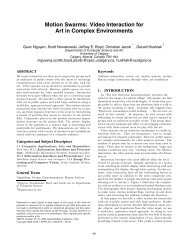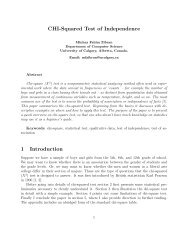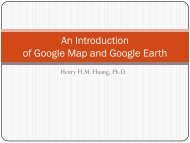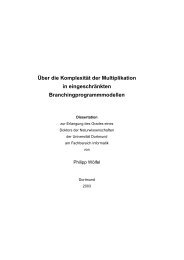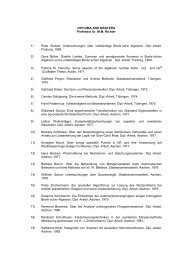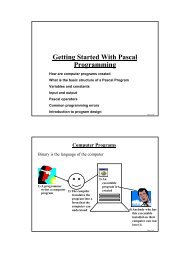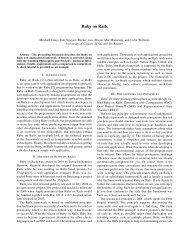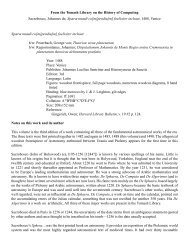Anianus.Computus cum commento.1488.Lyon.indd
Anianus.Computus cum commento.1488.Lyon.indd
Anianus.Computus cum commento.1488.Lyon.indd
Create successful ePaper yourself
Turn your PDF publications into a flip-book with our unique Google optimized e-Paper software.
From the Tomash Library on the History of Computing<br />
<strong>Anianus</strong>, <strong>Computus</strong> <strong>cum</strong> commento, 1488, Lyons<br />
<strong>Computus</strong> <strong>cum</strong> commento.<br />
Year: 1488<br />
Place: Lyons<br />
Publisher: Jean du Pré<br />
Edition: 3rd<br />
Language: Latin<br />
Figures: Rubricated initials & paragraph marks<br />
Binding: Eighteenth-century grey-blue boards and label<br />
Pagination: ff. [40]<br />
Collation: a–e8 (a1 blank)<br />
Size: 195x142 mm<br />
Reference:<br />
Smith, David Eugene; Le comput manuel de Magister <strong>Anianus</strong>, Paris, Editions E.<br />
Droz, 1928, p. 106.<br />
Smith, David Eugene; Rara Arithmetica…, New York, Chelsea Publications, 1970,<br />
p. 31.<br />
Notes on the author and this work<br />
A computus is a work concerned with calculation of the church calendar and contains the rules for computing<br />
the date for Easter. In the “western” churches, Easter is the fi rst Sunday after the fi rst full moon after the spring<br />
equinox. Knowing the date for Easter for any given year, it is then possible to determine the dates for all the other<br />
movable Christian festivals. This calendar problem, essentially coordination of the solar with the lunar year, is<br />
of great consequence in the history of calculation in Europe, for it kept the study of mathematics alive during the<br />
so-called Dark Ages.<br />
Little is defi nitively known of Magister (master or teacher) <strong>Anianus</strong>; however, it is likely he was a French monk<br />
who lived in the second half of the thirteenth century at the Benedictine monastery of Aniane near Montpellier.<br />
His computus, which is well known in manuscript form, was fi rst printed in Paris in 1483, and this edition<br />
appeared fi ve years later.<br />
Most computus works tend to be prolix, obtuse and complex (see, for example, Schönborn; <strong>Computus</strong>, 1567,<br />
or Arnald of Villanova; <strong>Computus</strong>, 1501). In contrast, the <strong>Anianus</strong> computus is written in verse (including the<br />
fi rst printed Latin version of the verse Thirty days hath September…). The <strong>Anianus</strong> computations themselves are<br />
not algorithmic but are based on the use of the fi ngers and joints of the left hand as both a mnemonic aid and<br />
calculating device. The large number of incunable editions attests to the utility and popularity of this approachable<br />
work.<br />
This edition contains a short, fi ve page, commentary followed by the actual computus. It has three rather<br />
crudely drawn fi gures of the left hand as well as small circular devices and two pages of tables from which facts<br />
such as the golden number (the position in the lunar cycle for any given year) can be readily determined.<br />
For a succinct discussion of this method of computation, see Sachiko Kusukawa, A manual computer for<br />
reckoning time, in Claire Richter Sherman, Writing on hands. Memory and knowledge in early modern Europe.<br />
Seattle, 2000, pp. 28–34. For an earlier discussion of this work, see David Eugene Smith; Le comput manuel de<br />
Magister <strong>Anianus</strong>, 1928.
General notes on the condition of older books<br />
From the Tomash Library on the History of Computing<br />
<strong>Anianus</strong>, <strong>Computus</strong> <strong>cum</strong> commento, 1488, Lyons<br />
Books as old as this usually suffer from some problems just because of the wear they have been subjected to<br />
over the many years of their existence. One usually noticeable condition item is known as browning or foxing of<br />
the paper - usually brown or yellow areas due to the chemical action of a micro-organism on the paper. This can<br />
vary dramatically from page to page, often depending on such variables as the contents of the paper used, the<br />
composition of the ink used by the printer, and the dampness (or lack of) that the work has been exposed to over<br />
the years. Where these images were badly foxed, some slight manipulation of the intensity of the colors has been<br />
done to ease the reading of the foxed page. Any other notable condition problem will be commented upon near<br />
the image concerned.<br />
Use of these notes and images<br />
This fi le has been made available by the generosity of Erwin Tomash and the Tomash Library. It is free for use<br />
by any interested individual, providing that no commercial use is made of its contents and any non commercial<br />
use acknowledges the source. The notes and illustrations have been produced by Erwin Tomash and Michael R.<br />
Williams, both of whom beg forgiveness for any errors that they might have made.<br />
© 2009 by Erwin Tomash and Michael R. Williams. All rights reserved.
Front cover, spine and rear cover of the volume.<br />
From the Tomash Library on the History of Computing<br />
<strong>Anianus</strong>, <strong>Computus</strong> <strong>cum</strong> commento, 1488, Lyons
From the Tomash Library on the History of Computing<br />
<strong>Anianus</strong>, <strong>Computus</strong> <strong>cum</strong> commento, 1488, Lyons<br />
Front paste down endpaper with the book plate of Sir George Shuckburgh and the Tomash Library label.<br />
George Shuckburgh (1751—1804) was an English mathematician and astronomer and was also the Member of<br />
Parliament for Warwickshire from 1780 to 1801. He was a Fellow of the Royal Society and won its highest award,<br />
the Copley Medal, in 1798.
Recto of the front free endpaper.<br />
From the Tomash Library on the History of Computing<br />
<strong>Anianus</strong>, <strong>Computus</strong> <strong>cum</strong> commento, 1488, Lyons
Verso of the front free endpaper.<br />
From the Tomash Library on the History of Computing<br />
<strong>Anianus</strong>, <strong>Computus</strong> <strong>cum</strong> commento, 1488, Lyons
From the Tomash Library on the History of Computing<br />
<strong>Anianus</strong>, <strong>Computus</strong> <strong>cum</strong> commento, 1488, Lyons<br />
Another front free endpaper (recto - the verso is identical).
From the Tomash Library on the History of Computing<br />
<strong>Anianus</strong>, <strong>Computus</strong> <strong>cum</strong> commento, 1488, Lyons<br />
This is the beginning of the commentary (usually referred to as the incipit) mentioned in the introductory notes.
Page 2 of the incipit.<br />
From the Tomash Library on the History of Computing<br />
<strong>Anianus</strong>, <strong>Computus</strong> <strong>cum</strong> commento, 1488, Lyons
Page 3 of the incipit.<br />
From the Tomash Library on the History of Computing<br />
<strong>Anianus</strong>, <strong>Computus</strong> <strong>cum</strong> commento, 1488, Lyons
Page 4 of the incipit.<br />
From the Tomash Library on the History of Computing<br />
<strong>Anianus</strong>, <strong>Computus</strong> <strong>cum</strong> commento, 1488, Lyons
Page 5 of the incipit.<br />
From the Tomash Library on the History of Computing<br />
<strong>Anianus</strong>, <strong>Computus</strong> <strong>cum</strong> commento, 1488, Lyons
Verso of page 5 of the incipit.<br />
From the Tomash Library on the History of Computing<br />
<strong>Anianus</strong>, <strong>Computus</strong> <strong>cum</strong> commento, 1488, Lyons
From the Tomash Library on the History of Computing<br />
<strong>Anianus</strong>, <strong>Computus</strong> <strong>cum</strong> commento, 1488, Lyons<br />
This is the fi rst page of the actual computus by <strong>Anianus</strong>.
From the Tomash Library on the History of Computing<br />
<strong>Anianus</strong>, <strong>Computus</strong> <strong>cum</strong> commento, 1488, Lyons<br />
As mentioned in the introductory notes, the computus uses the left hand as both a mnemonic device and to<br />
help with the calculations. This rather crude drawing of a left hand, palm up, is used to “set the scene” for this<br />
discussion.
From the Tomash Library on the History of Computing<br />
<strong>Anianus</strong>, <strong>Computus</strong> <strong>cum</strong> commento, 1488, Lyons<br />
Again a rather crude drawing of the left hand, this time palm down.
From the Tomash Library on the History of Computing<br />
<strong>Anianus</strong>, <strong>Computus</strong> <strong>cum</strong> commento, 1488, Lyons
From the Tomash Library on the History of Computing<br />
<strong>Anianus</strong>, <strong>Computus</strong> <strong>cum</strong> commento, 1488, Lyons
From the Tomash Library on the History of Computing<br />
<strong>Anianus</strong>, <strong>Computus</strong> <strong>cum</strong> commento, 1488, Lyons
From the Tomash Library on the History of Computing<br />
<strong>Anianus</strong>, <strong>Computus</strong> <strong>cum</strong> commento, 1488, Lyons
From the Tomash Library on the History of Computing<br />
<strong>Anianus</strong>, <strong>Computus</strong> <strong>cum</strong> commento, 1488, Lyons
From the Tomash Library on the History of Computing<br />
<strong>Anianus</strong>, <strong>Computus</strong> <strong>cum</strong> commento, 1488, Lyons
From the Tomash Library on the History of Computing<br />
<strong>Anianus</strong>, <strong>Computus</strong> <strong>cum</strong> commento, 1488, Lyons
From the Tomash Library on the History of Computing<br />
<strong>Anianus</strong>, <strong>Computus</strong> <strong>cum</strong> commento, 1488, Lyons
From the Tomash Library on the History of Computing<br />
<strong>Anianus</strong>, <strong>Computus</strong> <strong>cum</strong> commento, 1488, Lyons
From the Tomash Library on the History of Computing<br />
<strong>Anianus</strong>, <strong>Computus</strong> <strong>cum</strong> commento, 1488, Lyons
From the Tomash Library on the History of Computing<br />
<strong>Anianus</strong>, <strong>Computus</strong> <strong>cum</strong> commento, 1488, Lyons
From the Tomash Library on the History of Computing<br />
<strong>Anianus</strong>, <strong>Computus</strong> <strong>cum</strong> commento, 1488, Lyons
From the Tomash Library on the History of Computing<br />
<strong>Anianus</strong>, <strong>Computus</strong> <strong>cum</strong> commento, 1488, Lyons
From the Tomash Library on the History of Computing<br />
<strong>Anianus</strong>, <strong>Computus</strong> <strong>cum</strong> commento, 1488, Lyons
From the Tomash Library on the History of Computing<br />
<strong>Anianus</strong>, <strong>Computus</strong> <strong>cum</strong> commento, 1488, Lyons
From the Tomash Library on the History of Computing<br />
<strong>Anianus</strong>, <strong>Computus</strong> <strong>cum</strong> commento, 1488, Lyons
From the Tomash Library on the History of Computing<br />
<strong>Anianus</strong>, <strong>Computus</strong> <strong>cum</strong> commento, 1488, Lyons
From the Tomash Library on the History of Computing<br />
<strong>Anianus</strong>, <strong>Computus</strong> <strong>cum</strong> commento, 1488, Lyons
From the Tomash Library on the History of Computing<br />
<strong>Anianus</strong>, <strong>Computus</strong> <strong>cum</strong> commento, 1488, Lyons
From the Tomash Library on the History of Computing<br />
<strong>Anianus</strong>, <strong>Computus</strong> <strong>cum</strong> commento, 1488, Lyons
From the Tomash Library on the History of Computing<br />
<strong>Anianus</strong>, <strong>Computus</strong> <strong>cum</strong> commento, 1488, Lyons<br />
This is the page with the famous “Thirty Days hath September...” In this version it reads:<br />
Annus solaris ex mensibus est duodenis (the solar year is divided into 12).<br />
Ja fe mar ap... (January, February, March , April ...).<br />
Juni aprilis september... (June, April, September and November)<br />
Dat trigita dies: reliquis supadditur vne (have 30 days: the rest are incireased by 1)<br />
The last three lines explain that February has an added day on leap years (known as bisextile years because the<br />
extra day was added as an extra “sixth” day before the fi rst of March).
From the Tomash Library on the History of Computing<br />
<strong>Anianus</strong>, <strong>Computus</strong> <strong>cum</strong> commento, 1488, Lyons
From the Tomash Library on the History of Computing<br />
<strong>Anianus</strong>, <strong>Computus</strong> <strong>cum</strong> commento, 1488, Lyons
From the Tomash Library on the History of Computing<br />
<strong>Anianus</strong>, <strong>Computus</strong> <strong>cum</strong> commento, 1488, Lyons
From the Tomash Library on the History of Computing<br />
<strong>Anianus</strong>, <strong>Computus</strong> <strong>cum</strong> commento, 1488, Lyons
From the Tomash Library on the History of Computing<br />
<strong>Anianus</strong>, <strong>Computus</strong> <strong>cum</strong> commento, 1488, Lyons
From the Tomash Library on the History of Computing<br />
<strong>Anianus</strong>, <strong>Computus</strong> <strong>cum</strong> commento, 1488, Lyons
From the Tomash Library on the History of Computing<br />
<strong>Anianus</strong>, <strong>Computus</strong> <strong>cum</strong> commento, 1488, Lyons
From the Tomash Library on the History of Computing<br />
<strong>Anianus</strong>, <strong>Computus</strong> <strong>cum</strong> commento, 1488, Lyons
From the Tomash Library on the History of Computing<br />
<strong>Anianus</strong>, <strong>Computus</strong> <strong>cum</strong> commento, 1488, Lyons
From the Tomash Library on the History of Computing<br />
<strong>Anianus</strong>, <strong>Computus</strong> <strong>cum</strong> commento, 1488, Lyons
From the Tomash Library on the History of Computing<br />
<strong>Anianus</strong>, <strong>Computus</strong> <strong>cum</strong> commento, 1488, Lyons
From the Tomash Library on the History of Computing<br />
<strong>Anianus</strong>, <strong>Computus</strong> <strong>cum</strong> commento, 1488, Lyons
From the Tomash Library on the History of Computing<br />
<strong>Anianus</strong>, <strong>Computus</strong> <strong>cum</strong> commento, 1488, Lyons
From the Tomash Library on the History of Computing<br />
<strong>Anianus</strong>, <strong>Computus</strong> <strong>cum</strong> commento, 1488, Lyons
From the Tomash Library on the History of Computing<br />
<strong>Anianus</strong>, <strong>Computus</strong> <strong>cum</strong> commento, 1488, Lyons
From the Tomash Library on the History of Computing<br />
<strong>Anianus</strong>, <strong>Computus</strong> <strong>cum</strong> commento, 1488, Lyons
From the Tomash Library on the History of Computing<br />
<strong>Anianus</strong>, <strong>Computus</strong> <strong>cum</strong> commento, 1488, Lyons
From the Tomash Library on the History of Computing<br />
<strong>Anianus</strong>, <strong>Computus</strong> <strong>cum</strong> commento, 1488, Lyons
From the Tomash Library on the History of Computing<br />
<strong>Anianus</strong>, <strong>Computus</strong> <strong>cum</strong> commento, 1488, Lyons
From the Tomash Library on the History of Computing<br />
<strong>Anianus</strong>, <strong>Computus</strong> <strong>cum</strong> commento, 1488, Lyons
From the Tomash Library on the History of Computing<br />
<strong>Anianus</strong>, <strong>Computus</strong> <strong>cum</strong> commento, 1488, Lyons
From the Tomash Library on the History of Computing<br />
<strong>Anianus</strong>, <strong>Computus</strong> <strong>cum</strong> commento, 1488, Lyons
From the Tomash Library on the History of Computing<br />
<strong>Anianus</strong>, <strong>Computus</strong> <strong>cum</strong> commento, 1488, Lyons
From the Tomash Library on the History of Computing<br />
<strong>Anianus</strong>, <strong>Computus</strong> <strong>cum</strong> commento, 1488, Lyons
From the Tomash Library on the History of Computing<br />
<strong>Anianus</strong>, <strong>Computus</strong> <strong>cum</strong> commento, 1488, Lyons
From the Tomash Library on the History of Computing<br />
<strong>Anianus</strong>, <strong>Computus</strong> <strong>cum</strong> commento, 1488, Lyons
From the Tomash Library on the History of Computing<br />
<strong>Anianus</strong>, <strong>Computus</strong> <strong>cum</strong> commento, 1488, Lyons
From the Tomash Library on the History of Computing<br />
<strong>Anianus</strong>, <strong>Computus</strong> <strong>cum</strong> commento, 1488, Lyons
From the Tomash Library on the History of Computing<br />
<strong>Anianus</strong>, <strong>Computus</strong> <strong>cum</strong> commento, 1488, Lyons
From the Tomash Library on the History of Computing<br />
<strong>Anianus</strong>, <strong>Computus</strong> <strong>cum</strong> commento, 1488, Lyons
From the Tomash Library on the History of Computing<br />
<strong>Anianus</strong>, <strong>Computus</strong> <strong>cum</strong> commento, 1488, Lyons
From the Tomash Library on the History of Computing<br />
<strong>Anianus</strong>, <strong>Computus</strong> <strong>cum</strong> commento, 1488, Lyons
From the Tomash Library on the History of Computing<br />
<strong>Anianus</strong>, <strong>Computus</strong> <strong>cum</strong> commento, 1488, Lyons
From the Tomash Library on the History of Computing<br />
<strong>Anianus</strong>, <strong>Computus</strong> <strong>cum</strong> commento, 1488, Lyons
From the Tomash Library on the History of Computing<br />
<strong>Anianus</strong>, <strong>Computus</strong> <strong>cum</strong> commento, 1488, Lyons
From the Tomash Library on the History of Computing<br />
<strong>Anianus</strong>, <strong>Computus</strong> <strong>cum</strong> commento, 1488, Lyons
From the Tomash Library on the History of Computing<br />
<strong>Anianus</strong>, <strong>Computus</strong> <strong>cum</strong> commento, 1488, Lyons
From the Tomash Library on the History of Computing<br />
<strong>Anianus</strong>, <strong>Computus</strong> <strong>cum</strong> commento, 1488, Lyons
From the Tomash Library on the History of Computing<br />
<strong>Anianus</strong>, <strong>Computus</strong> <strong>cum</strong> commento, 1488, Lyons
From the Tomash Library on the History of Computing<br />
<strong>Anianus</strong>, <strong>Computus</strong> <strong>cum</strong> commento, 1488, Lyons
From the Tomash Library on the History of Computing<br />
<strong>Anianus</strong>, <strong>Computus</strong> <strong>cum</strong> commento, 1488, Lyons
From the Tomash Library on the History of Computing<br />
<strong>Anianus</strong>, <strong>Computus</strong> <strong>cum</strong> commento, 1488, Lyons
From the Tomash Library on the History of Computing<br />
<strong>Anianus</strong>, <strong>Computus</strong> <strong>cum</strong> commento, 1488, Lyons
From the Tomash Library on the History of Computing<br />
<strong>Anianus</strong>, <strong>Computus</strong> <strong>cum</strong> commento, 1488, Lyons<br />
These tables are useful for calculating the date of Easter and other Christian festivals.<br />
The Golden Number (Aureus numerus) associates the phases of the moon with the calendar year (a cycle that<br />
repeats every 19 years so there are 19 golden numbers). The dominical letter (Littere domincales) is a letter from<br />
a to g which, for non-leap years, indicates which days of a year are Sundays. Assign the letter a to January 1,<br />
b to January 2, etc. then if the dominical letter for this year is b all days marked b will be a Sunday. For a full<br />
explanation of the calculation of Christian festivals (particularly Easter) consult any good encyclopedia.
From the Tomash Library on the History of Computing<br />
<strong>Anianus</strong>, <strong>Computus</strong> <strong>cum</strong> commento, 1488, Lyons
From the Tomash Library on the History of Computing<br />
<strong>Anianus</strong>, <strong>Computus</strong> <strong>cum</strong> commento, 1488, Lyons
From the Tomash Library on the History of Computing<br />
<strong>Anianus</strong>, <strong>Computus</strong> <strong>cum</strong> commento, 1488, Lyons<br />
This register lists the collation of the volume: a, b, c, d and e, each with 8 pages.
The printer’s mark of Jean du Pré.<br />
From the Tomash Library on the History of Computing<br />
<strong>Anianus</strong>, <strong>Computus</strong> <strong>cum</strong> commento, 1488, Lyons
From the Tomash Library on the History of Computing<br />
<strong>Anianus</strong>, <strong>Computus</strong> <strong>cum</strong> commento, 1488, Lyons
From the Tomash Library on the History of Computing<br />
<strong>Anianus</strong>, <strong>Computus</strong> <strong>cum</strong> commento, 1488, Lyons
Rear paste down end paper.<br />
From the Tomash Library on the History of Computing<br />
<strong>Anianus</strong>, <strong>Computus</strong> <strong>cum</strong> commento, 1488, Lyons
From the Tomash Library on the History of Computing<br />
<strong>Anianus</strong>, <strong>Computus</strong> <strong>cum</strong> commento, 1488, Lyons



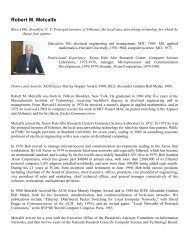
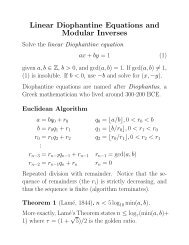

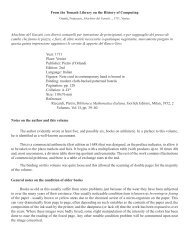
![Alfontii regis castelle illustrissimi celestiu[m]](https://img.yumpu.com/15135040/1/190x245/alfontii-regis-castelle-illustrissimi-celestium.jpg?quality=85)
